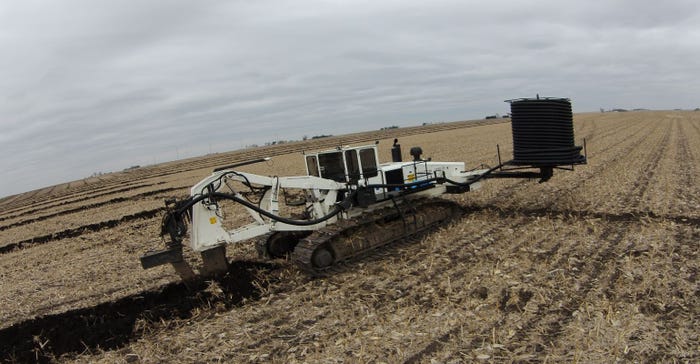
“We’re busier than ever,” says Mark Shortz, a drainage contractor who also farms near Danville, Ill., with family and two partners. “When I’m cutting soybeans I see that time in the combine as my calm before the storm. There’s really no end in sight.” Photo Mark Shortz
Most farmers breathe a sigh of relief at the end of a long harvest season. Not Mark Shortz.
That’s because the east-central Illinois corn and soybean farmer also happens to be a drainage contractor. So when Shortz finishes soybean harvest his next job is just waiting for him – and won’t end until soils freeze up some time this winter.
“We’re busier than ever,” says Shortz, who farms near Danville, Ill., with family and two partners. “When I’m cutting soybeans I see that time in the combine as my calm before the storm. There’s really no end in sight.”
Perfect storm
Drainage has always been, for the most part, a no-brainer investment for farmland owners. But the next few years are lining up be a perfect storm for contractors like Shortz. Why?
Following two profitable years farmers are looking to invest in their business and lower tax bills;
With land prices through the roof it’s a sound way to improve ROI productivity and profitability on land you already own, without having to buy more;
Alternative investments, such as grain bins or new combines, are seeing shortages, high demand, cost increases, or supply chain holdups. Drain projects did see an uptick in cost, due in part to post Covid demand surge as well as – ironically - the Feb. 2021 Texas storm that knocked out production of high density plastic. Even so, drainage project costs have not jumped nearly as high as other big-ticket farm investments.
A fourth benefit, more difficult to quantify, is how drainage can help farmers manage weather extremes. According to the National Climate Assessment heavy downpours are increasing, especially over the last three to five decades, with the largest increases in the Midwest and Northeast. More flooded fields delay planting and cause yield-robbing disease. In 2019 the U.S. saw record number of acres enrolled in Prevent Planting due to incessant rainfall.
Demand surge
In the short-term, though, it’s strong yields and high prices that are driving drainage demand, says Jennifer Furkin, vice president at Springfield Plastics, a plastic pipe manufacturer in Auburn, Ill.
“In this industry we can’t make it fast enough,” she says. “Demand is at an all-time high.”
A desire to make good investments and lower tax liability is also driving demand.
“Farmers are limited in what they can purchase in terms of hard assets like combines, and pickup trucks,” says Furkin. “In earlier days you might have been able to just buy those off the dealer lot, but that’s not as easy the last few years due to Covid and supply shortages.
�“When farmers have money to invest and can’t get a combine for 18 months, they’re looking for other investments opportunities – so many of them turn to drainage.”
Booked up
All those advantages mean orders are piling up for drainage contractors. “We took delivery of fall pipe this spring just to make sure we had pipe available for projects, but if you’re a land owner or neighbor who called tomorrow and said you wanted to spend money by the end of the year, sorry - we’re all booked up,” says Shortz. “It’s a good problem to have for us. We’re working on filling up next year’s fall schedule, to be honest.”
The backlog of work means steady business, but the jobs still depend on weather. “By next March we might have run all winter with our self-propelled plows, or the weather could turn between Thanksgiving and Christmas, and bad weather could mean we lose two months of tiling,” says Shortz. “So we have to communicate that risk to our customers – we’re weather dependent.”
Cost of drainage depends in part how close your farm is to an outlet, but most systems cost from $1,000 to $1,500 per acre, adds Shortz. “In our area there’s a lot of 60 to 80 foot spacings on pattern tiling; some can get down to 30-foot spacing and that costs more. In general the cost is divided 50-50 between pipe materials and labor/installation.
What kind of land would offer a quick ROI from improved waterways and drainage? Obviously land that has not been improved yet. But even the good stuff, like drummer Flanagan soils in east central Illinois, may be candidates. Most corn belt states have about 30 to 70% of row crop land tiled (see slideset).
“There’s still a tremendous amount of ground that still needs pattern tile,” says Shortz. “Where we are used to be swampland at one point. We have 100-year-old clay tiles that are taxed and overloaded.
“There’s a lot of class A really good farmland where the productivity index is high already but also lays really wet, so drainage plays a huge role on how productive that land is,” he adds. “Drummer Flanagan might sell for high value at auction but without proper drainage you’re not going to get full potential in any given year.”
Prime tile installation season in the Midwest is directly after harvest. Bigger farms with a lot of ground strategically do installations every year. Some farmers split projects, doing a 160-acre farm in one year and a 300-acre farm tied in to the mains the next year.
With increased demand Furkin also sees farmers line up projects in spring before crops come up.
“Fifteen years ago we were very seasonal – just fall installations,” she notes, “but now we’re seeing more installations done in spring and summer.”
Tax management
If you’re lucky enough to have a drainage project already started – or finished sometime this calendar year – remember it does need to be a completed project to enjoy full tax benefits, says Bob Krogmeier, CPA with CliftonLarsonAllen, and a Farm Futures blogger on farm finance.
“If you only get half a project done by end of year technically you can only depreciate what’s done by that point,” he says. “If it’s a $200,000 project and you only have half completed by end of December, make sure you pay the contractor that $100,000,” says Krogmeier. “An investment needs to be ‘in use’ or ‘ready to use;’ you can’t just pay for the tile and have it laying around on the farm and depreciate the cost. Technically that’s just inventory.”
You can either take bonus depreciation, which allows the business to take 100% depreciation in one year (a rule that may be changed for 2023); or Section 179, another form of accelerated depreciation with a limit on how much equipment or capital assets you purchase in a year. Section 179 is limited to a maximum deduction of $1,080,000 for equipment (anything other than buildings) and a property purchased limit up to $2,700,000 in the year 2022. Bonus depreciation has no purchase limit.
Timely planting
It’s hard to nail down drainage ROI, but Furkin says she has seen a minimum of 15% return on investment in unimproved land. While new combines look nice, they aren’t going to pay you back the first five minutes after you buy one.
“You’ll see the yield bump but even more important, drainage gives you a chance to be timely,” she says. “Once you put in drainage your farm operation has the flexibility to plant or harvest or do field work whenever you want, because you can get in there and work. It’s no longer a muddy hole.
“Those undrained properties are the last ones harvested and last planted in spring,” she continues. “Installing drainage makes a world of difference when you don’t have to replant fields anymore.”
Shortz agrees.
“Bin sites have made us money, but drainage, year in and year out, is an easy sell,” he says. “For my own farm and others, drainage is the best option.”
About the Author(s)
You May Also Like






